Perhaps the most lobbied criticism towards Japanese developers today is that they’ve fallen behind the gameplay standards and innovation of other developers. The developers of Yakuza 4, however, could not care less about that sentiment. Like the crime organizations the game focuses on, Yakuza 4 is defiantly traditional in structure, ignoring the advances of modern games in favor of deliberately paced, over-the-top Japanese melodrama, lavish cutscenes, and gameplay that values cinematic production value over interactivity.The problem with Yakuza 4, however, is that the game itself doesn’t always work in favor of the traditions the game reveres so much. Wonky, unrefined gameplay and poor technology under the hood hinder Yakuza 4 at every turn, and the result is an experience that's mildly enjoyable.
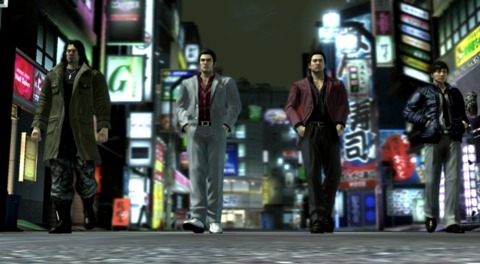
The best thing in Yakuza 4 is its highly involved, emotional story. The game once again follows the trials of Kazuma Kiryu, the former chairman of Tokyo's Tojo crime clan, and this time introduces three other seemingly unrelated men whose lives will soon become intertwined, like a Japanese version of Heavy Rain. They include Akiyama, the laid-back, fiscally irresponsible owner of a loaning business; Tanimura, the corrupt rookie cop who takes advantage of illegal enterprises; and Saejima, a hulking hitman who has spent 25 years in Tokyo’s secret prisons.
These four all find that their separate paths lead to the murder of a low-ranking gangster, and further events soon thrust them into a conflict that threatens to embroil all of Tokyo in gang violence. The story casts every major organization in Tokyo--the Yakuza, the police, the government-- as members of an elaborate conspiracy, tied into events that happened both in the distant past and in the first Yakuza game. Yakuza 4’s story of corruption and betrayal is so littered with revelations, backstabs, twists, and turns that even Phoenix Wright might describe it as a bit convoluted.
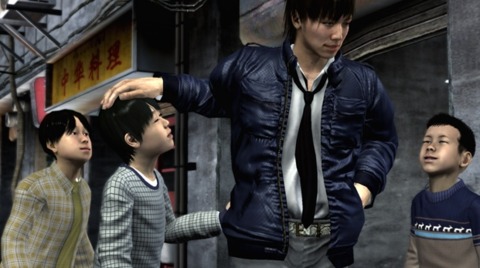
That ridiculous, twist-heavy story would easily collapse under its own stupid weight if it weren’t anchored by a solid group of characters. The four protagonists of Yakuza 4 bring such emotional conviction to every encounter that you’ll be hard pressed to take the game’s action at arm's length. Even when the game reaches the heights of Japanese melodrama (and it does), the story remains compelling thanks to great voice acting and super-detailed, highly emotive character models that sell the action. It may be ludicrous crime drama (and there are some notable plot holes), but Yakuza 4’s cinematic storyline makes for a fun ride throughout, and offers a very different take on the “organized crime” tales we see in America.
In fact, that feeling of being a cultural anthropologist is one of the best things about playing Yakuza 4. It’s fascinating to see the ways a Japanese developer like Sega would choose to render the kind of hyper-detailed urban environments that have dominated the video game landscape in recent years. The fictional Tokyo district of Kamurocho is depicted with incredibly detailed set dressing. Cooked fowl hanging inside restaurants, secret mahjong dens, and ridiculously detailed pachinko machines are just a handful of the weird sights I saw during my time in video-game Tokyo, and they go a long way toward making Kamurocho feel like a real, distinct environment. It’s no surprise why, looking at the game from a distance, so many players think of the Yakuza franchise as the closest thing to a Japanese equivalent of Grand Theft Auto.
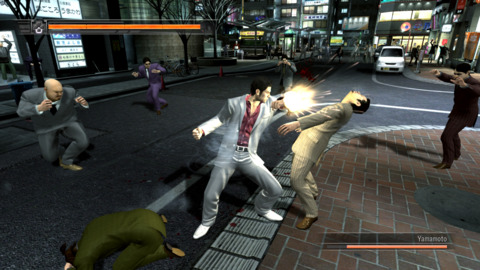
But beyond the urban city setting, Yakuza 4 has very little in common with GTA or other open world series. Yakuza 4 is a very traditional game, rooted in the conventions of any '90s-era JRPG. With a story objective on the map, you wander through the expansive city, get into various random encounters on the way, play a few minigames to break up the action, and eventually fight an overly powerful boss, all to trigger the next lavish and exciting cutscene that furthers the current story thread.
In keeping with a classic formula, Yakuza 4 sticks with a similarly traditional gameplay convention; the beat-'em-up. Upon entering random combat with one of Kamurocho’s irritable gangs, you'll use a pretty standard assortment of weak and strong attacks to dispatch enemies. In addition to the straightforward tactics of simply hitting your opponents, players can use items that randomly spawn at the start of the fight, and there’s very little in this game more satisfying than beating a person half to death with a tiny Japanese moped. The combat is basic but very satisfying, replete with savage attacks that break opponents' noses and bruise them all over.
However, the combat isn’t necessarily fluid; unlike more modern interpretations of the beat-'em-up that allowed players to reverse their momentum and direction with ease, Yakuza 4 is still utilizes the traditional combo-focused, animation-prioritized combat. As a result, it’s often hard to redirect your attacks at specific opponents, and encounters will too often end with your character taking damage from opponents who you cannot adequately respond to.
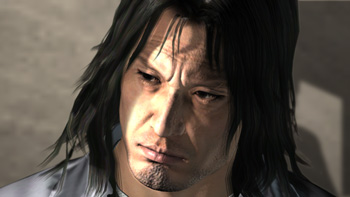
But Yakuza's combat is hardly the game's worst offense. The biggest problem with Yakuza 4 is that every single element in the game serves to halt the game’s momentum. Whether you’re entering into a fight, transitioning between menus, or performing a super move, Yakuza 4 seems to constantly be stopping the action to load some new element. Even performing a character’s super move causes the game to hitch up in order to load the cinematic move into your current fight. It often feels like Yakuza 4’s technology isn’t properly optimized for the game it actually is, and the result is that the game is oftentimes waiting for the technology to catch up to the action.
Yakuza 4 is a tightly packed game, filled with hours and hours of content, but it also feels deliberately contained, filled with barriers preventing you from seeing that content. The city of Kamurocho is technically open for exploration, but it’s very difficult to know where to look for a mission. The game rarely provides information on where to find various side activities or missions. About the only times I found Yakuza 4’s side activities were when the game literally halts story progress and pulls the player into one of these minigames. It’s a bad system that undercuts the tension of the story by introducing a side quest in the most obvious, egregious way possible, and it makes the player feel like they’re taking time off from an deeply personal, important mission for nonsense.
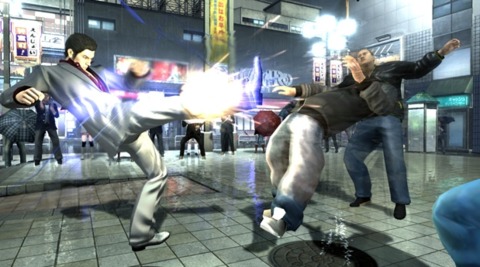
And that just covers the few side missions I was able to find. Over the course of my original playthrough, I barely stumbled upon the game’s vast array of side activities (including gambling, dating hostesses, bowling, baseball, underground tournament fighting, mining, and photography, to name a few). Worse still is that the optional content really doesn’t impact your play at all. Sure, you’ll receive money, special items and new fighting techniques by completing side missions, but you don’t need any of those things to finish the game, and you could go through the entirety of Yakuza 4 without touching a side mission. No optional content has been more optional than the side missions of Yakuza 4. It’s too bad because many of those side missions are ridiculously deep, highly detailed missions with great writing and a ton of value; I spent hours just completing one of these many side quests. Only at the very end of the game does Yakuza 4 open up into a sandbox, allowing you to switch between the four characters and explore the city at your leisure, but it occurs literally 15 minutes before the credits roll. You’ll unlock a sandbox mode that allows you to explore Kamurocho and take on missions at your leisure upon completing the game, but it’s a shame that side content couldn’t be more naturally integrated (or easy to access) from within the core game.
It often seems like Yakuza 4 is conspiring against itself, holding its own cool features back behind technology and game design. It’s not that Yakuza 4 is a bad game, but rather that too many of the game’s eccentricities don’t work in its favor. Still, If you love the idea of watching Japanese men rip their shirts off, flash their elaborate back tattoos, and charge at each other while shouting like a wounded bobcat, then I can’t recommend Yakuza 4 enough; if you're that sort of person, this is exactly the kind of ridiculous Japanese drama you’ve been looking for. But for those players for whom the setting isn’t immediately compelling, Yakuza 4’s technology flaws, simple gameplay, and awkward structure too often work against the game to make it a firm recommendation.